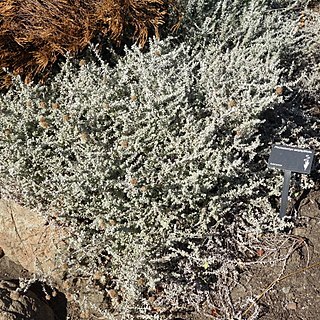Much-branched, straggling, dwarf shrub, 0.25-1.21 m high. Leaves alternate, subsessile, broadly elliptic to suborbicular, apex mucronate, margins entire but undulate, upper surface thinly white-tomentose or glabrous, lower surface white-tomentose. Capitula disciform, many in small, congested clusters, terminating branchlets; involucral bracts in ± 3 rows, imbricate, apex obtuse, milk white. Outer female florets usually fewer than disc florets, narrowly tubular, yellow, sometimes tinged pink. Disc florets tubular below, slightly expanded above, yellow, sometimes tinged pink. Flowering time Oct.-Apr. Pappus of scabrid bristles, bases cohering lightly by patent cilia and lightly fused. Cypselae small, oblong, hairy.
A small shrub. The branches are slender and young parts have a white coating. The leaves are 10 mm long by 7 mm wide. The edges are wavy.
Similar to P. polifolia but leaves suborbicular with undulate margins, floral bracts milky white.

